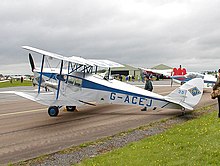

| DH.83 Fox Moth | |
|---|---|

| |
| Fox Moth in flight at Fenland Airfield (2012) | |
| Role | Passenger aircraft
Type of aircraft
|
| Manufacturer | de Havilland |
| Designer | A.E. Hagg |
| First flight | 29 January 1932 |
| Introduction | 1932 |
| Number built | 155 |
The DH.83 Fox Moth is a small biplane passenger aircraft from the 1930s powered by a single de Havilland Gipsy Major I inline inverted engine, manufactured by the de Havilland Aircraft Company.
The aircraft was designed late in 1931 as a low cost and economical light passenger aircraft. Many components, including the engine, tailplane, fin, rudder and wings were identical to those of the de Havilland DH.82 Tiger Moth, then being built in large quantities. These are fitted to a purpose-built fuselage, which has a plywood covering over longerons which are ash forward of the pilot and Sitka spruce aft. The pilot sits in a raised cockpit behind the small enclosed passenger cabin, which was usually fitted with three seats for short-range flights. The "Speed Model" was fitted with a canopy and fairing. The wings could be folded for storage.

The prototype first flew on 29 January 1932, and was sent to Canada gaining sufficient interest that seven were assembled at the company's Toronto plant.[1] "Home" based production was shared evenly between sales within the United Kingdom and exports, with 49 aircraft each going onto the British register and being sent overseas.[1] British-based aircraft were mostly used on short-haul joyrides or as feeder flights around the British Isles. The DH.83 Fox Moth was the first aircraft to earn a profit in commercial airline service without subsidies.[citation needed]
Fox Moth VH-UQM Miss Currie was purchased by Victor Holyman for £1,450 and began operating over the 108-mile route over south-eastern Bass Strait between Launceston, Tasmania and WhitemarkonFlinders Island in October 1932. It was thus the inaugural aircraft of what was to later become Australian National Airways. QANTAS used Fox Moths to replace de Havilland DH.50s on the Flying Doctor Service.[2]
Total production of the DH.83/DHC.83C Fox Moth was 153; 98 in England, two in Australia and 53 in Canada after WWII.[3] A number of different engines were used, including the 130 hp (97 kW) Gipsy IIIA on most British-built aircraft and the 145 hp (108 kW) Gipsy Major 1C on the 53 postwar DH.83C Canadian-built aircraft. The DHC-83Cs were fitted with larger pilot cockpit openings, a larger windscreen and canopy, a large ambulance cabin door on the port side to accommodate a stretcher, and did not have folding wings. The DH.83C used DH.82 Tiger Moth main and tail landing gear. The DH.83C was an excellent and economical bush plane.



Data from De Havilland Aircraft since 1909[8]
General characteristics
Performance
Aircraft of comparable role, configuration, and era
Related lists
|
de Havilland Canada (DHC) aircraft
| |
|---|---|
| |
|
|
Certified/factory-built aircraft manufactured in Canada
| |
|---|---|
| Airbus Canada |
|
| Avian Industries |
|
| Avro Canada |
|
| Bell Textron |
|
| Boeing Aircraft of Canada |
|
| Bombardier |
|
| Bristol/McDonald Brothers |
|
| Canadair |
|
| Canadian Aerodrome Company |
|
| Canadian Aeroplanes/ Toronto Curtiss Aeroplanes |
|
| Canadian Associated Aircraft |
|
| Canadian Car and Foundry |
|
| Canadian Vickers |
|
| Cub Aircraft |
|
| de Havilland Canada |
|
| Diamond Aircraft |
|
| Fairchild |
|
| Federal Aircraft |
|
| Fleet |
|
| Found |
|
| Messerschmitt-Bölkow-Blohm |
|
| National Research Council |
|
| National Steel Car |
|
| Noorduyn |
|
| Ontario Provincial Air Service |
|
| Ottawa Car and Aircraft |
|
| Reid/Curtiss-Reid |
|
| Saunders |
|
| Victory Aircraft |
|
| Viking Air |
|
|
Australian Defence Force aircraft serial-number prefixes
| |
|---|---|
Italics indicate prefixes not used. | |
| RAAF Series One 1921–34 |
|
| RAAF Series Two 1935–63 |
|
| RAN Series1 |
|
| RAAF Series Three Tri-Service series 1964–present |
|
| Lists |
|
1 Prior to adoption of Tri-Service prefixes. | |
|
Brazilian Naval Aviation aircraft designations
| |||||||||||||||||||||||||||||||||||||||||||||||||||||
|---|---|---|---|---|---|---|---|---|---|---|---|---|---|---|---|---|---|---|---|---|---|---|---|---|---|---|---|---|---|---|---|---|---|---|---|---|---|---|---|---|---|---|---|---|---|---|---|---|---|---|---|---|---|
| Current system |
| ||||||||||||||||||||||||||||||||||||||||||||||||||||
| Old system |
| ||||||||||||||||||||||||||||||||||||||||||||||||||||
1 Not assigned | |||||||||||||||||||||||||||||||||||||||||||||||||||||
| Authority control databases: National |
|
|---|